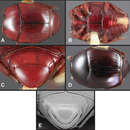Description
(
İngilizce
)
Zookeys tarafından sağlandı
Length: 1.97–2.06 mm, width: 1.65–1.84 mm; body rufopiceous, elongate oval; frons very weakly impressed; frontal stria rounded at sides, interrupted over antennal bases, arcuate across front; supraorbital stria fine, more or less complete, but narrowly detached from sides of frontal stria; epistoma weakly convex; labrum about twice as wide as long, weakly, asymmetrically emarginate apically; both mandibles with small, subacute basal tooth; pronotum lacking prescutellar impression, with very fine, inconspicuous ground punctation, lacking coarse lateral punctures; marginal pronotal stria broadly interrupted behind head; submarginal pronotal stria continuous along lateral and anterior margins; median pronotal gland openings simple, about two-thirds pronotal length from anterior margin; elytron with one complete epipleural stria, outer subhumeral stria complete or interrupted at middle, inner subhumeral stria absent, dorsal striae 1-2 complete, 3rd stria present as fine scratch in basal third and as stria in apical third, 4th and 5th striae present in apical fourth, sutural stria present in apical two-thirds; prosternal keel weakly projecting at base, with complete carinal striae connected in rather broad anterior arch; anterior mesoventral margin shallowly emarginate, with complete marginal stria; mesometaventral stria broadly arched forward to near marginal mesoventral, sinuate at sides, continued posterolaterad by lateral metaventral stria, abbreviated apically; 1st abdominal ventrite with single lateral stria abbreviated posteriorly; postmetacoxal fovea small, situated behind inner corner of metacoxa; propygidium with ground punctation fine and sparse, with coarse punctures small, rather deep, and separated by their diameters or slightly more; pygidium with fine, dense ground punctation throughout, lacking coarser punctures except along basal margin; marginal pygidial sulcus very strong and deep, widening slightly to basal corners, but lacking larger basal foveae. Male genitalia (Figs 106F–J): accessory sclerites present, small; T8 with sides evenly convergent to subtruncate apex, apical emargination narrow, basal emargination narrow and deep, nearly meeting basal membrane attachment line, ventrolateral apodemes well developed basally, narrowed to apex; S8 with sides subparallel, apical guides narrow, evenly developed along sides, halves approximate along most of ventral midline; T9 with sides subparallel, weakly arcuate to narrow, weakly convergent apices; T10 with halves separate; S9 with stem narrow, parallel sided, rounded at base, with narrow apical emargination, apical flanges thin, separate; tegmen narrow, with sides weakly rounded, widest in apical half, with bluntly subacute apex, medioventral process thin, narrowly ‘U’-shaped, projecting beneath about one-third from base; median lobe about half tegmen length, with proximal apodemes strongly differentiated into thick portion with finer proximal extensions; basal piece just over one-third tegmen length.
- lisans
- cc-by-3.0
- telif hakkı
- Michael S. Caterino, Alexey K. Tishechkin
- bibliyografik atıf
- Caterino M, Tishechkin A (2013) A systematic revision of Operclipygus Marseul (Coleoptera, Histeridae, Exosternini) ZooKeys 271: 1–401
- yazar
- Michael S. Caterino
- yazar
- Alexey K. Tishechkin

